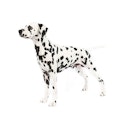Dalmatian Dog Breed

- Size
- Medium/Large
- Height
- 19 to 24 inches at the withers
- Weight
- 45 to 70 pounds
- Coat
- Short
- Color
- White with black spots
- Energy
- High
- Activities
- Agility, Conformation, Obedience, Rally Obedience, Tracking
The Dalmatian is the original coach dog, well known for riding proudly atop a fire engine or running with a carriage. Dalmatians are both smart and muscular, with stamina to keep up the pace.
Temperament
This highly intelligent breed thrives with a loving family, who will find them to be clever, affectionate and devoted pets.
Dalmatians were originally bred to guard horses and coaches, and that watchdog instinct is still present in the breed today. They are high-energy dogs that need daily exercise and are great companions for runners and hikers.
Characteristics
Although a Non-Sporting breed, Dalmatians are muscular, high-endurance athletes with powerful hindquarters that propel them effortlessly. Of course, the Dalmatian’s most striking characteristic is his unique, spotted coat.
Lifespan
10 to 13 years
Colors
The Dalmatian’s short, sleek coat always stands out, with black- or liver-colored spots on a white background.
Shedding
Dalmatians do shed, but occasional baths and weekly brushing will help remove dead hair and reduce shedding.
Health
Overall, Dalmatians are healthy, active dogs that require regular exercise to keep them happy (and out of trouble).
This breed can be prone to deafness, which is minimized by responsible breeding. Kidney stones are another concern.
Best Dog Food for Dalmatian Dogs & Puppies
Because of their energy level, Dalmatians may benefit from a food for active dogs. For Dalmatians who need help with weight management, consider a healthy weight formula.
Dalmatian puppies should eat puppy food for their first year of life to aid in their growth and development.
History
There is some dispute about the Dalmatian’s origins. Images of spotted dogs running alongside chariots have been found on painted walls in Egyptian tombs. We do know that by the early 1800s the breed had become linked to the region called Dalmatia, which was located in Central Europe along the Adriatic Sea.
The Dalmatian’s occupation was “coach dog.” His job was to run alongside horse-drawn coaches, and guard them while they were unoccupied.
From the caravans of the wandering Romani people, to the well-appointed carriages of British nobles, to the horse-drawn fire engines of the 1800s, Dalmatians have performed this function throughout history, establishing themselves in their role.
Today, Dalmatians can even be seen accompanying the famous Budweiser Clydesdales as they journey along parade routes.
Facts
- Dalmatians are born pure white, with their spots appearing around 7 to 10 days later.
- The English have a close relationship with this breed. Their nicknames for Dalmatians include English Coach Dog, the Carriage Dog, the Plum Pudding Dog and the Spotted Dick.
- Just like each person’s fingerprints, the pattern of spots on each Dalmatian’s coat is unique.
- Even though they are no longer needed to guard today’s fire trucks, Dalmatians are still kept as mascots at many firehouses.